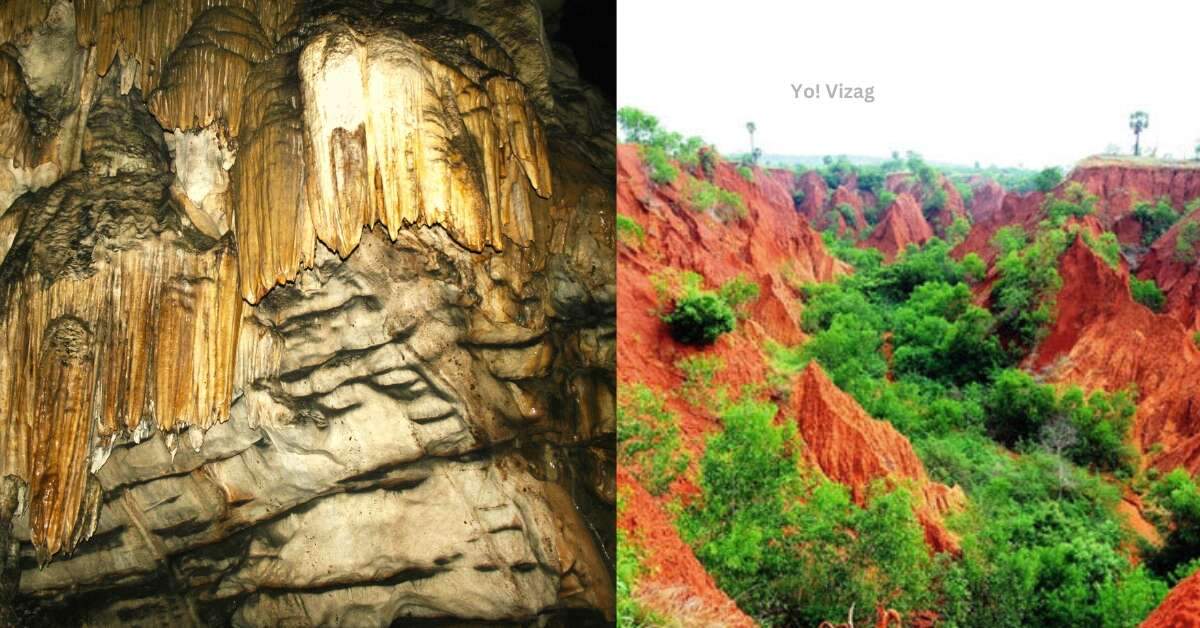

Vizag is a city that is often striving for growth and yearning for development. In this quest for progress, urbanisation has been unavoidable, and it often shifts the focus away from what makes the city truly unique: its natural beauty. Known as the city between the hills and the seas, this location has truly blessed Visakhapatnam with a wealth of special natural wonders. Here are a few of them:
1. Erra Matti Dibbalu
The coastal red sand dunes, known locally as “Erra Matti Dibbalu,” are located about 20 km northeast of Visakhapatnam near Bheemunipatnam. Similar formations can be found in only two other places in South Asia: the Teri sands in Tamil Nadu and a site in Sri Lanka. Some theories suggest that the dunes are as old as 1.8 million years. These ancient formations help provide valuable insights into global climate changes, sea-level fluctuations, and monsoonal patterns of the past.
The red sand dunes are made unique by their deep gullies, which have been formed by the action of wind and sea water over the Earth. The water, cutting through the land, created deep valleys or gullies. Furthermore, the signature red colour of the sand is caused by a process called ferrogination, where the iron-rich mineral hematite oxidizes when exposed to water, sunlight, and air.
2. Natural Bridge
Natural bridges, or arches, are rock formations that form when erosion causes a rock ridge to become hollow underneath. A striking example of this can be found at Mangamaripeta Beach, Thotlakonda, where a natural arch was carved after thousands of years of wind and sand influence.
It is said that this bridge was formed around 10,000 years ago, close to the Last Ice Age. It is similar to the famous arch on Tirumala Hills, which is a National Geological Monument.
3. Sea Caves
Sea caves are formed along the coast because of the constant action of waves upon easily-weathered rocks Khondalite outcrops along Visakhapatnam’s coastline have made this phenomenon possible.
The most well-known example of sea caves is at Seethapalem Beach, located about 70 km from Visakhapatnam. Traces of sea cave formations can also be observed at Rushikonda and Thotlakonda which were shaped by wave activity during higher sea levels in ancient times.
4. Promontories
A promontory is a raised mass of land that juts out into a lower landscape or body of water. Visakhapatnam is home to several promontories, such as those at Kailasagiri Hill, Yarada Hill, and Thotlakonda Hill. The most notable is Dolphin’s Nose, a rocky promontory standing 358 meters above sea level.
5. Rock formations
Wave-cut rocks are unique formations on Vizag’s beaches that have come about because of the constant erosion of rocky cliffs by waves extending outward into the ocean. Also known as a wave-cut bench, these platforms can be found at a certain. The relentless action of waves on rocky cliffs leads to the creation of these features. These formations can be seen near areas such as Rushikonda, Ramadri, and Thotlakonda.
Along the coast at locations such as Gangavaram and Rushikonda, unique serpentine hood structures have formed. These concave, snake-like shapes are carved by relentless wave action. The presence of these features provide evidence of ancient sea levels and wave patterns.
6. Borra Caves
The Borra Caves are some of the largest and deepest caves in India.
These natural wonders, located about 90 km from Visakhapatnam, extend to a depth of 80 meters. Formed by the Gosthani River, the caves are made of limestone and display impressive stalactites and stalagmites. Archaeological evidence has shown that the caves were inhabited by humans as far back as 30,000 to 50,000 years ago!
7. Volcanic Ash Deposits at Araku
75,000 years ago, one of the largest volcanic activities occurred when Mount Toba in Indonesia erupted. Its ash deposits travelled 2,500 km across the Bay of Bengal to reach India, and two of these ash deposit sites are in Araku Valley.
Though they are some of the less-known natural wonders near Visakhapatnam, these two deposits would be helpful in understanding how climate evolved about two million years ago.
Having formed over the course of hundreds of years, these natural wonders in Visakhapatnam are grand and awe-inspiring in their own right. However, recent concerns have emerged over their preservation. Erra Matti Dibbalu has faced destruction from bulldozers, and the natural arch at Thotlakonda is weakening due to unrestricted foot traffic. As we move forward, it is a must that we recognize these sites for their geographical importance and advocate for their protection!
Disclaimer: Credits for some of the information presented in this article go to the research paper, “Visakhapatnam: A Potential Geopark of India”, authored by Dr Rajashekhar Reddy and T Karuna Karudu.
Stay tuned to Yo! Vizag website and Instagram for more city updates.
This post was last modified on 25/09/2024 7:29 pm
The search for new activities and experiences never ends. It's undoubtedly exciting to have one's…
The death of an 11-year-old girl near a church in Kancharapalem, Visakhapatnam, on the night…
Visakhapatnam district is set to see a major new development aimed at empowering the differently-abled…
A gruesome double murder in Rajeev Nagar, Ward 86, Visakhapatnam, was reported on 26 April…
For one born in Vizag or any Telugu city, there comes a time after primary…
As the weekend approaches, the yearning for rest and relaxation grows. With summer temperatures soaring,…
Leave a Comment